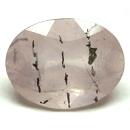|
|
||||||||||||||||
|
||||||||||||||||
|
||||||
|
|
|
|
Bismuthinite
(inclusions
in Quartz) |
|
| | |
| Discovered in 1832; IMA status: Valid (pre-IMA; Grandfathered) | ||
|
| ||
|
Chemistry |
|
|
| |
|
Bi2S3 | |
|
|
Bismuth Sulfide |
|
Molecular Weight: |
514.16 gm |
|
Composition: |
Bismuth |
8129 % |
Bi |
|
|
|
|
Sulfur |
18.71 % |
S |
|
|
|
|
|
100.00 % |
|
|
|
|
|
|
||||
|
Classification |
|
|
| |
|
Sulfides | |
|
2/D.08-40 | |
|
|
2 : SULFIDES and SULFOSALTS (sulfides, selenides,
tellurides; arsenides, antimonides, bismuthides; sulfarsenites,
sulfantimonites, sulfbismuthites, etc.) |
|
Related to: |
Stibnite Group. Aikinite-Bismuthinite Series. |
|
Members of Group: |
Stibnite Group: Antimonselite, Bismuthinite, Guanajuatite, Stibnite |
|
Varieties: |
Antimonian Bismuthinite, Argentiferous Bismuthinite, Horobetsuite |
|
Synonyms: |
Bismuth Glance, Bismuthine, Bismutholamprite, Bismutinite, Csiklovaite |
|
|
|
|
Crystal Data |
|
|
|
|
|
Crystals, up to 12 cm, stout prismatic to acicular, elongated and striated || [001]. Commonly massive with foliated or fibrous texture. |
|
|
None |
|
|
|
|
|
Physical Properties |
|
|
|
|
|
Perfect and Easy on {010}, Imperfect on {100} and {110} |
|
|
Sectile |
|
|
Flexible, somewhat Sectile |
|
|
2.0 - 2.5 |
|
|
6.78 (g/cm3) |
|
|
None |
|
|
Not Radioactive |
|
|
|
|
|
Optical Properties |
|
|
|
|
|
Lead-Gray to tin-White, with a Yellowish or iridescent tarnish |
|
|
Opaque |
|
|
Metallic |
|
|
R1R2: (400) 35.746.2, (420) 36.447.2, (440) 37.247.9, (460) 37.748.3, (480) 37.748.8, (500) 37.649.4, (520) 37.349.6, (540) 37.149.1, (560) 36.948.7, (580) 36.848.3, (600) 36.647.8, (620) 36.447.3, (640) 36.346.8, (660) 36.146.3, (680) 36.045.8, (700) 35.945.4 |
|
|
0.000 |
|
|
n/a |
|
|
None |
|
|
Strong, especially in oil |
|
|
|
|
|
Occurances |
|
|
|
|
|
Geological Setting: |
Typically in low- to high-temperature hydrothermal vein deposits, in tourmaline-bearing copper deposits in granite, in some gold veins formed at high temperatures, and in recent volcanic exhalation deposits. |
|
Common Associations: |
Bismuth, Aikinite, Arsenopyrite, Stannite, Galena, Pyrite, Chalcopyrite, Tourmaline, Wolframite, Cassiterite, Quartz |
|
Common Impurities: |
Pb, Cu, Fe, As, Sb, Se, Te |
|
Type Locality: |
Llallagua, Huanuni, Tazna, and Chorolque districts, Potosi, Bolivia |
|
Year Discovered: |
1832 |
|
View mineral photos: | |
|
|
|
|
More Information |
|
|
|
|
|
| |
|
|
|
|
Distribution
of Bismuthinite is widespread. From the Llallagua, Huanuni,
Tazna, and Chorolque districts, Potosν, Bolivia. From
Guanajuato, Mexico. In the USA, large crystals at the
Victoria mine, Dolly Varden district, Elko County; in
a number of mines in the Goldfield district, Esmeralda
County, and elsewhere in Nevada. From Moravicza and
Baita (Rιzbαnya), Romania. At Schneeberg and Altenberg,
Saxony, Germany. From a number of mines in Cornwall,
England. In the Mt. Biggenden mine, Queensland, Australia.
At Fefena, Madagascar. Exceptional crystals from Spind,
Farsum, Norway. |
|
|
We
have not photographed our Bismuthinite gems
yet. Please
check back soon. |
